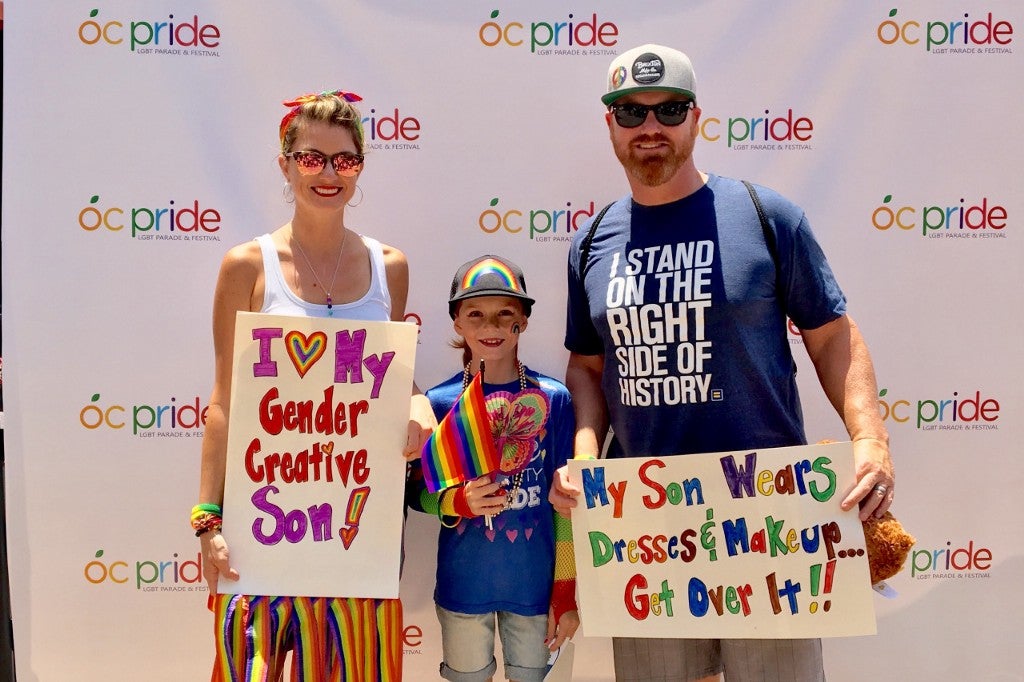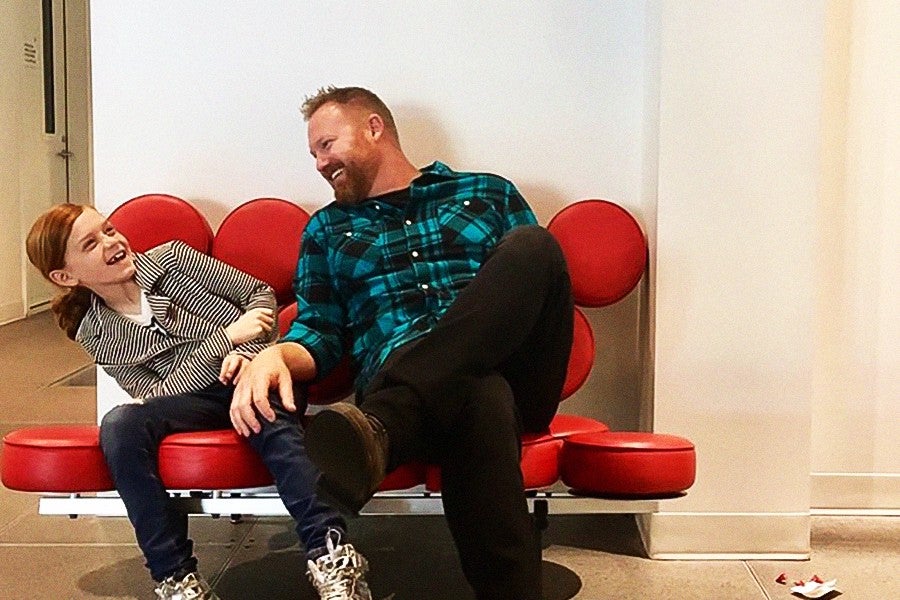Every day this summer before sewing camp, Matt Duron would take his younger son, 10-year-old C.J., to the craft store. The only boy in the class, and a creative overachiever, C.J. insisted on picking out new fabrics and patterns before the actual training started. According to his mom Lori’s blog, “Raising My Rainbow,” C.J. has created a lot of drag queen-inspired art in his short life, including felt interpretations of some of his favorite stars from RuPaul’s Drag Race — all with a little help from his dad.
C.J. isn’t much like Matt was at 10. He doesn’t play football or like trucks and guns. He prefers Barbies and the color pink, so much so that when he was 3 years old, Lori had his vision tested to determine if he could even see the color blue. C.J. is gender nonconforming, meaning he very much considers himself a boy but doesn’t exist within the typical confines placed on youthful masculinity. Needless to say, for Matt, raising C.J. has been a departure from the life he lived as a boy, in a home where even his mom was a “tomboy.” Parenthood pivoted Matt’s journey from that of a former college football player and Orange County cop to that of a reluctant activist, rallying for his son’s right to freely express himself while facing one hell of a learning curve.

My wife and I have been married for 17 years. We started dating in high school and have enjoyed a great, healthy marriage. I was a police officer in Orange County for almost 20 years, many of which were spent as a detective, after a brief stint as a firefighter at the start of my career. I retired last year and now have more time than ever to spend with C.J. and his 14-year-old brother Chase.

From a young age, Chase has always been exactly what you’d expect from a “typical” boy. He was into sports and trucks and everything else that was considered masculine. When C.J. was born, we expected more of the same. But starting around age 2, we found out that C.J.’s interests were vastly different — he had no interest in the Thomas the Train or the other “boy” hand-me-downs from his brother.
During this time, we spent a lot of time hanging out with other cops and their families. Especially in the detective’s bureau, everyone’s families become very intertwined because our hours were so crazy and we would often have the same days off. I found that anytime my friends had daughters, C.J. would get lost in their rooms for hours, playing with the dolls and all of their “girl” toys.
The same thing happened during trips to Target. Chase would ask to check out the toys and take C.J. with him, only to lose his younger brother to the all-pink Barbie aisle until it was time to leave. What struck us most is how full of life he was when playing in the pink aisle or with his friend’s dolls. To be honest with you, it was crazy to witness, and we wondered if his behavior was “normal.”
When C.J. was 3 or 4, Lori began doing research to find out what was going on. But there wasn’t much out there that explained our situation. Basically, it boiled down to two terms — “gender creative” and “gender dysphoria,” which I absolutely hated because it named my child’s identity in a way that gave it a negative connotation.
There’s nothing negative about the way C.J. is. He’s not dysphoric, searching for some answer.
He’s super happy just being himself.
We also turned to local doctors for help. Unfortunately, a lot of the questions they asked seemed to insinuate or suggest sexual deviancy in some way. That made me angry and disgusted. It also made me stop trusting them when it came to C.J.’s preferences. I told Lori we were going to raise C.J. the same way we raised Chase — instilling the same values and virtues — but that we would follow his lead and love him no matter what. I was like, “If he loves Barbies, let’s give him Barbies. If he loves wearing dresses, let’s buy him dresses.”

Not that it was easy. We did go through periods of depriving him of Barbies and toys like that, thinking if we didn’t allow him to play with that stuff, he would get into more masculine toys. But C.J. was unhappy. That’s been part of the reason why we’ve been so open about our experiences raising him — we wanted to create a conversation that wasn’t about changing who your child is, but that offered practical advice to parents raising gender-creative children. Because when we first started searching for information, there wasn’t much of it; we were asking questions that weren’t getting answered.
A lot of people would ask us if C.J. was gay. My response was simple: “C.J. is 5 years old. There isn’t sexuality behind his behavior.”
Based on research, we do realize that if a child is gender creative or gender non-binary, the probability of him becoming gay or transgender is extremely high. But we’ll cross that bridge when we come to it. Overall, my basic feeling is, “Who gives a shit?” And: “It’s not fair to expect him to know all that stuff right now.”
I’d be lying, though, if I said we hadn’t lost friends due to our decision to support C.J. That’s one of the things that sucks. When you go through something like this as a family, you realize that a lot of your friends are merely acquaintances — people who will fall by the wayside when things get shitty or hard.
Such former “friends” would openly question our choices, or make comments about us needing to go to church more often.
We are, in fact, Christians. But it’s hard to be involved with most churches given C.J.’s gender-creative identity since a lot of them don’t agree with his lifestyle, or the lifestyle we’re building around our family. I don’t want to send my kids to youth group and find out they’re preaching homophobia or saying there’s something wrong with transgender people. I never want my kids to feel like they were born wrong, and I definitely don’t want my older son to think that about his brother.
Religious or not, everyone is always after definitions. I hate, though, putting labels on things, especially kids. Childhood is all about growth and fluidity. Our son might be 10 years old now and using terms like gender creative, but when he’s 13 or 14 years old, he might be using terms like, “I’m gay, and I like men.” That’s an issue we’ve had to struggle with — being able to respect him for who he is without letting our attempts to understand him limit who he tells us he is.
To that end, C.J. has always been the best at explaining who he is. Often, he just says, “I’m a boy who likes girl things.”
Chase is in high school now, and he’s the most incredible big brother. He’s extremely protective, almost to a fault. If a waitress calls C.J. “she” or misgenders him in any way — whether it’s because of his long hair or his preference for T-shirts with feminine cuts — Chase is quick to say, “That’s my brother!” Likewise, I take C.J. to Chase’s football practices — he’s a bit of a star on his team — and C.J. freaks out while watching him play. He’s so impressed by Chase’s talent and skill. In that way, I’ve hopefully taught both of them to celebrate each other’s differences.
My relationship with Lori makes raising C.J. easier, too. If you look at the statistics, most parents with gender-variant children get divorced. Oftentimes, the trouble is that one parent supports the child’s gender expression and the other doesn’t. So Lori and I have always prioritized being on the same team, no matter what happens. We talk about everything before we do it and tend to our marriage first, because we recognize that our marriage is the nucleus of our family.
That’s not to say there aren’t days when I don’t know what I’m doing, and days when we don’t know what we’re doing. I often wonder if I’ve screwed something up.
But I think if you’re a good parent, you have to wonder that.
— As told to Tierney Finster

